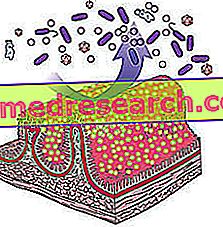Introduction
It is known how physical exercise - especially when it involves high-intensity eccentric movements - can generate a general state of muscle soreness, classically defined as delayed-onset muscle soreness or DOMS, within the next 24-48 hours.

The DOMS is the main cause of the decrease in the physical performance of an athlete, with inevitable repercussions on the state of psycho-physical health.
Over time it has been tried, through different methods, to remedy this condition, succeeding in some cases to obtain also good results.
Nutritional integration
Several authors have reported the benefits of different nutritional interventions in the control and management of DOMS.
For this reason, an appropriate integration protocol could prove to be valuable in preserving the athlete's muscular health status, allowing adequate recovery.
Caffeine
It is known that caffeine has an important saver effect against glycogen, promoting lipid oxidation instead.
This selective metabolic modularity, according to some authors, would be accompanied by a better muscular energy yield and the consequent reduction of the DOMS occurrence.
In addition to metabolic activity, recent studies have attributed to caffeine an antagonistic activity against adenosine, blocking the adenosine receptors centrally and significantly reducing the perception of central fatigue
In these experiments, conducted on healthy individuals subjected to eccentric exercise on the biceps, the ingestion of caffeine significantly reduced the onset of DOMS after 48 and 72 hours compared to placebo.
Omega 3
The integration with polyunsaturated fatty acids of the Omega 3 series would have proved to be very useful in the prevention of DOMS.
Different studies, in fact, would show how their integration, even at low dosages and for limited periods of time, would be useful in reducing concentrations of inflammatory cytokines in the immediate post workout, controlling muscle microtraumas and the consequent onset of pain and muscle soreness .
Results also enhanced by the significant drop in post-workout concentrations of markers of oxidative damage, such as creatine phosphokinase, lactate dehydrogenase and malonyl sialdehyde.
Taurine
Taurine is a biologically active molecule present in skeletal muscle, important in maintaining cellular homeostasis, in protecting against oxidative damage and in controlling cellular osmolarity.
Recent studies, dated 2014, would have demonstrated the usefulness of the integration with Taurine in reducing concentrations of markers of muscle damage and contextually in delaying, and in some cases preventing, the onset of DOMS.
Benefits that would be further enhanced by the simultaneous pre-workout intake of branched chain amino acids
Polyphenols
Polyphenols are a set of biologically active molecules with a strong antioxidant and anti-inflammatory power.
Considering the role of the mediators of phlogosis and reactive oxygen species in the genesis of DOMS, it would appear clear that the intake of these phytonutrients, such as pomegranate polyphenols, could significantly reduce the occurrence of DOMS to 24- 96 hours compared to placebos.
Similar results would have been observed also following the daily ingestion of cherry juice or cranberry juice, known for its marked antioxidant properties.
Panax Ginseng
According to recent evidence, the use of Panax ginseng in the immediate aftermath of training would have determined, in trained subjects, a reduction in DOMS to 96 hours from exercise compared to placebo.
Activity that, contrary to expectations, would not have been supported by the reduction of concentrations of inflammatory cytokines as observed in the other integration protocols, but to molecular mechanisms not yet characterized.
Conclusions
Nutritional integration is certainly a valid ally in the fight against DOMS.
The nutritional intervention should be oriented to the control of post-work-out inflammation and of the oxidative damage induced by intense physical exercise.
The control of these activities would clearly be successful in the management of athletic training.
Dosages, nutritional interventions, timing and method of use should be defined by the health professional.
Bibliography
Jhun J, Lee J, Byun JK, Kim EK, Woo JW, Lee JH, Kwok SK, Ju JH, Park KS, Kim HY, Park SH, Cho ML. Red ginseng extract ameliorates autoimmune arthritis via regulation of STAT3 pathway, Th17 / Treg balance, and osteoclastogenesis in mice and human. Mediators Inflamm 2014; 351856.
Jówko E, Sacharuk J, Balasińska B, Ostaszewski P, Charmas M, Charmas R. Green tea extract supplementation gives protection against exercise-induced oxidative damage in healthy men. Nutr Res 2011; 31: 813-821.
Kuehl KS, Perrier ET, Elliot DL, Chesnutt JC. Effective of tart cherry juice in reducing muscle pain during running: a randomized controlled trial. J Int Soc Sports Nutr 2010; 7: 17.
Lenn J, Uhl T, Mattacola C, Boissonneault G, Yates J, Ibrahim W, Bruckner G. The effects of fish oil and isoflavones on delayed onset muscle soreness. Med Sci Sports Exerc 2002; 34: 1605-1613.
Phillips T, Childs AC, Dreon DM, Phinney S, Leeuwenburgh C. A dietary supplement attenuates IL-6 and CRP after eccentric exercise in untrained males. Med Sci Sports Exerc 2003; 35: 2032-2037.
Tartibian B, Maleki BH, Abbasi, A. Omega-3 fatty acids supplementation attenuates inflammatory markers after eccentric exercise in untrained men. Clin J Sport Med 2011; 21: 131-137.



